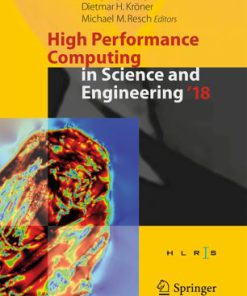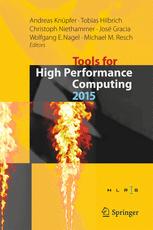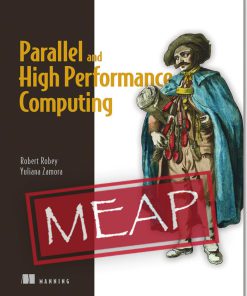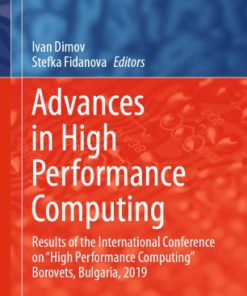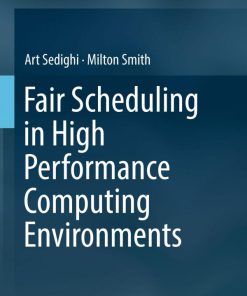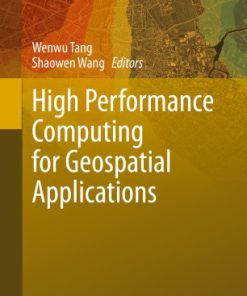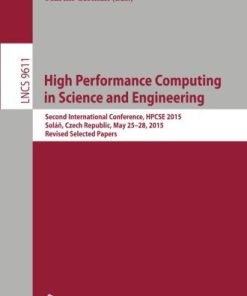High Performance Computing in Science and Engineering 15 1st Edition by Wolfgang Nagel, Dietmar Kröner, Michael Resch ISBN 9783319246338 331924633X
$50.00 Original price was: $50.00.$25.00Current price is: $25.00.
High Performance Computing in Science and Engineering 15 1st Edition by Wolfgang Nagel, Dietmar Kröner, Michael Resch – Ebook PDF Instant Download/Delivery: 9783319246338 ,331924633X
Full download High Performance Computing in Science and Engineering 15 1st Edition after payment
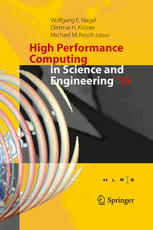
Product details:
ISBN 10: 331924633X
ISBN 13: 9783319246338
Author: Wolfgang Nagel, Dietmar Kröner, Michael Resch
High Performance Computing in Science and Engineering 15 1st Edition Table of contents:
-
Thermodynamics with 2+1+1 Dynamical Quark Flavors
1 Introduction
1.1 Reference Point: The Nf=2+1 Equation of State
2 Progress for the Charmed Equation of State
2.1 Line of Constant Physics
2.2 Additional Results
3 Production Specifics and Performance
3.1 Performance
3.2 Production
4 Outlook
5 Publications of the Project
5.1 Peer-Reviewed
5.2 Other
References
Numerical Evaluation of Multi-Loop Feynman Integrals
1 Introduction
2 Program Package and Technical Details
3 Heavy Quark Mass Relations to Four Loops
4 Anomalous Magnetic Moment of the Muon
5 Conclusions and Outlook
References
MCTDHB Physics and Technologies: Excitations and Vorticity, Single-Shot Detection, Measurement of Fr
1 Introduction to MCTDHB
2 Many-Body Dynamics of Vortices in 2D and 3D Computed with the R-MCTDHB Package
2.1 How Angular Momentum Hides in Phantom Vortices
2.2 Resonant Stirring of a BEC Leads to Fragmentation
2.3 Mechanism of Vortex Reconnection
2.4 Technical Details of the R-MCTDHB Studies
2.4.1 2D Computations
2.4.2 3D Computations
3 Two-Dimensional BECs in Circular Traps
4 Excitations with LR-MCTDHB: Benchmarks and Applications
4.1 Benchmark of LR-MCTDHB
4.2 Applications of LR-MCTDHB
5 Single Shot Simulations of Symmetry Breaking
6 Protocol for Direct Measurement of Fragmentation
7 Optimal Control with CRAB-MCTDHB
8 Concluding Remarks and Outlook
References
PAMOP Project: Petaflop Computations in Support of Experiments
1 Introduction
2 Parallel R-Matrix Photoionization
3 X-ray and Inner-Shell Processes
3.1 The Atomic Oxygen Iso-Nuclear Sequence
4 Valence Shell Photoionization
4.1 Tungsten (W) Atoms and Ions
4.2 Neutral Tungsten
4.3 Singly Ionized Tungsten
5 Charge Exchange
5.1 C6+ -H, and He collisions
6 Summary and Future Work
References
Monte Carlo Simulation of Crystal-Liquid Phase Coexistence
1 Introduction
2 The Model and Its Bulk Phase Behavior
3 Coexistence Pressure and Estimation of the Chemical Potential
4 Estimation of Crystal Nucleation Barriers
5 Conclusions and Outlook
References
A New Colloid Model for Dissipative-Particle-Dynamics Simulations
1 Introduction
2 Marble Model
3 Results and Discussions
4 Summary
References
Force Field Optimization for Ionic Liquids: FFOIL
1 Introduction
1.1 Report Structure
2 Project A: Graphite Structure and Planar Capacitor Simulation
2.1 Simulation Methods
2.1.1 Short-Range Electrode Interaction
2.1.2 Electrode Polarization Methods
2.1.3 Simulation Details
2.2 HPC Setup
2.3 Results
2.3.1 Method Benchmarks
3 Project B: Carbide-Derived Carbon Electrodes with Mixtures of EMIM BF4 and Acetonitril
3.1 Simulation Setup
3.1.1 Motivation
3.1.2 Models and Methods
3.2 HPC Resource Usage
4 FFOIL Outlook
Appendix 1: Project A
Appendix 2: Project B
References
The Small Scale Structure of the Universe
1 Introduction
2 The Reionization Period
2.1 The Simulations
2.2 Specific Simulations Ran and Sample Results
3 MaGICC CLUES to Galaxy Formation and Cosmology
3.1 Simulations and the MagICC Model
3.2 Simulated Galaxy Properties
3.2.1 Rotation Curves
3.2.2 Stellar Mass-Halo Mass
3.2.3 The Baryonic Tully-Fisher Relation
4 Summary
References
Part II Molecules, Interfaces, and Solids
Ab Initio Transport Calculations for Functionalized Graphene Flakes on a Supercomputer
1 Introduction
2 Methods
2.1 Transport Calculations
2.2 Implementation: Parallelization Efforts
3 Results
3.1 Overview of the Key Findings
3.2 Typical Numerical Parameters
3.3 Achieved DFT Performance on Cray XE6 (Hermit) and Cray XC40 (Hornet)
3.4 Parallelization of the Transport Module AITRANSS and Achieved Performance
3.5 Optimization of the Transport Module AitransS
3.5.1 Overview: Code Optimization
3.5.2 SpaceBlocks: Dividing Space into Blocks
3.5.3 MatrixInverse: Calculating the Green’s Function Inverse
4 Conclusions
References
Solving the Scattering Problem for the P3HT On-Chain Charge Transport
1 Introduction
2 Methodology
3 Results and Discussion
4 Conclusions
References
Ab-Initio Calculations of the Vibrational Properties and Dynamical Processes in Semiconductor Nanost
1 Introduction
2 Computational Methods
2.1 Vibrational Eigenmodes for Large Nanoclusters
2.2 Calculation of Electron-Phonon Coupling Matrix Elements
2.3 Time Dependent Evolution of the Population
2.4 Computational Details
3 Results
3.1 Carrier Relaxation in Colloidal Nanoclusters
3.2 Strains and Their Consequences on Vibrational Properties in Colloidal Core-Shell NCs
References
Large-Scale Modeling of Defects in Advanced Oxides: Oxygen Vacancies in BaZrO3 Crystals
1 Introduction
2 Methods
2.1 Computational Details
2.2 Computational Resources
3 Results and Discussion
3.1 Defective-Free Barium Zirconate
3.2 Oxygen Vacancies: Atomic and Electronic Properties
3.3 Oxygen Vacancies: Thermodynamic Properties
4 Conclusions
References
Interfacial Properties and Growth Dynamics of Semiconductor Interfaces
1 Introduction
2 Surface Reactivity of Cyclooctyne on Si(001) with DFT: Predicting Growth Processes for Semiconduct
2.1 Introduction
2.2 Computational Details
2.3 Optimizing Parallel Performance in VASP
2.4 Nudged Elastic Band Results
2.5 Ab-initio Molecular Dynamics Results
3 Gas Phase Decomposition of MOVPE Precursors: Prelude to Adsorption and Growth Studies
4 GaP/Si-Interfaces in Different Crystal Orientations
4.1 Strain in Growth Direction
4.2 Electrostatic Potentials Across the GaP/Si-Interface
5 Density Functional Computations on the Electronic Structure of Dilute GaAs: Method Validation
6 Scaling Tests
References
Atomistic Simulation of Oligoelectrolyte Multilayers Growth
1 Introduction
2 Goals and Overview of the System Under Study
3 Simulation Details
4 Mesoscopic Properties of the Four Layers System
References
Mechanochemistry of Cyclopropane Ring-Opening Reactions
1 Scientific Background
2 Results and Discussion
3 Conclusions
References
Part III Bioinformatics
Computational Modeling of a Biocatalyst at a Hydrophobic Substrate Interface
1 Introduction
2 Enzymes at Substrate Interfaces
3 Simulation Details
4 Modeling of Candida antarctica Lipase B Attached to a Triglyceride Layer
5 Modeling the Water Influx into the Active Site of Candida antarctica Lipase B at a Triglyceride-Wa
6 Applying the Solvent Flux Method to Candida antarctica Lipase B
7 Water Access Channels and Critical Amino Acid Positions Identified in Candida antarctica Lipase B
8 The Solvent Flux Method in the Context of Hydrolase Engineering
References
Dynathor: Dynamics of the Complex of Cytochrome P450 and Cytochrome P450 Reductase in a Phospholipid
1 Technical Description
1.1 NAMD Simulations
1.2 RAMD Simulations
2 Simulations of Membrane-Bound Complexes of P450 and CPR
2.1 Introduction
2.2 Methods
2.3 Results
3 Future Plans
References
Part IV Reactive Flows
Numerical Simulation of Turbulent Combustion with a Multi-Regional Approach
1 Introduction
2 Modeling Concepts
2.1 Combustion Modeling
2.2 Multi-Regional Solution Strategy
2.2.1 Basic Idea
2.2.2 Performance Improvement
3 Application
3.1 Computational Method
3.2 Numerical Setups
3.3 Simulation Results
3.4 Performance
4 Summary and Outlook
References
Numerical Simulations of Rocket Combustion Chambers on Massively Parallel Systems
1 Introduction
2 Numerical Method
3 Non-ideal Fluids in Rocket Combustors
3.1 Non-ideal Thermodynamics
3.2 Non-ideal Molecular Transport Properties
3.3 Non-ideal Flow Phenomena
4 The M3 Combustion Chamber
5 Performance Comparison of HERMIT and HORNET
6 Conclusion
References
Part V Computational Fluid Dynamics
High-Resolution Numerical Analysis of Turbulent Flow in Straight Ducts with Rectangular Cross-Sectio
1 Introduction
2 Numerical Methods
2.1 Algorithm and Implementation
2.2 Code Performance
2.3 Simulations
3 Results and Discussions
3.1 Coherent Structure Analysis on Open Duct Flows
3.2 Reynolds Number Dependence in Open Duct Flows
4 Conclusions and Outlook
References
Investigation of Convective Heat Transfer to Supercritical Carbon Dioxide with Direct Numerical Simu
1 Introduction
2 Computational Details
2.1 Governing Equations and Numerical Method
2.2 Inflow Turbulence
2.3 Code Validation
2.4 Simulation Conditions
3 Results and Discussion
3.1 Heat Transfer Character
3.2 Flow Statistics
3.3 Visualization
4 Computational Performance
5 Conclusions
References
DNS Investigation of the Primary Breakup in a Conical Swirled Jet
1 Introduction
2 Numerical Method
2.1 Simulation of Multiphase Flows with VOF and PLIC
3 Numerical Setup
3.1 Inlet Velocity Profile
3.2 Description of the Domain
4 Results
4.1 Grid Study
4.2 Comparison with Different Inlet Profiles
5 Performance
6 Conclusion
References
Numerical Simulation of Subsonic and Supersonic Impinging Jets
1 Introduction
2 Numerical Method
2.1 Discretisation
2.2 Computation of Statistical Variables
2.3 High Performance Computing
2.4 Computational Domain
2.5 Boundary Conditions
2.6 Kolmogorov Scales
2.7 Boundary Layer
2.8 Dynamic Mode Decomposition
3 Subsonic Jet Impingement Heat Transfer
3.1 Introduction
3.2 Results
3.2.1 Influence of The Reynolds Number
3.2.2 The Dynamic Modes of Jet Impingement Heat Transfer
3.3 Conclusion
4 Supersonic Impinging Jet Noise
4.1 Introduction
4.2 Results
4.2.1 Characterisation of the Discrete Tones of the Supersonic Impinging Jet: Distinction to Screech
4.2.2 The Origin of the Impinging Tones
4.3 Conclusion
References
On the Impact of Forward-Facing Steps on Disturbance Amplification in Boundary-Layer Flows
1 Introduction
2 Numerical Method
2.1 Selective Frequency Damping
2.2 Parallelisation
3 Results
3.1 Base Flows
3.2 Disturbance Excitation and N-factor Computations
3.3 Limits of the Present Approach: High Steps in the Supersonic Regime
4 Conclusions
References
Large-Scale Simulations of a Non-generic Helicopter Engine Nozzle and a Ducted Axial Fan
1 Introduction
2 Numerical Method
3 Validation Test
4 Helicopter Engine Jet
4.1 Grid Convergence Test
4.2 Analysis of Two Variants of the Nozzle Geometry
5 Axial Fan
5.1 Grid Convergence Test
5.2 Volume Flow Rate Variation
6 Computational Specifications and Scalability Analysis
7 Conclusion
References
Large-Eddy Simulation of a Scramjet Strut Injector with PilotInjection
1 Introduction
2 Experimental Setup
3 Numerical Method and Computational Details
4 Numerical Setup
5 Results
References
Turbulence Resolving Flow Simulations of a Francis Turbine with a Commercial CFD Code
1 Introduction
2 Numerical Methods
2.1 Domain Decomposition
2.2 Turbulence Modeling
2.2.1 Scale Adaptive Simulation
2.2.2 Delayed Detached Eddy Simulation
2.3 Temporal and Spatial Discretisation
3 Francis Turbine Case
3.1 Computational Setup
3.2 Global Machine Data
3.3 Flow Analysis
3.4 Vortex Rope
3.5 Turbulence Evaluation
4 Computational Resources
5 Conclusion
References
Numerical Investigation of a Full Load Operation Point for a Low Head Propeller Turbine
1 Introduction
2 Numerical Setup
3 Turbulence Modeling
3.1 k-ω-SST
3.2 SAS-SST
4 Results
4.1 Integral Quantities
4.2 Flow Analysis
4.3 Vortex Rope
4.4 Turbulence Evaluation
5 Speed-Up
5.1 Hermit
5.2 Hornet
6 Conclusion and Outlook
References
Detached Eddy Simulation of Flow and Heat Transfer in Swirl Tubes
1 Introduction
2 Numerical Setup
3 Results
3.1 Flow Field
3.2 Wall Shear Stress
3.3 Heat Transfer
3.4 Pressure Loss
4 Cray Performance Analysis
5 Current and Future Work
6 Conclusion
References
Evaluation and Control of Loads on Wind Turbines under Different Operating Conditions by Means of CF
1 Introduction
2 Numerical Setup and Computational Details
2.1 Simulation of Yawed Inflow (CaseBase & CaseYaw)
2.2 Simulations of the Load Control Case (CaseControl)
2.3 Numerical Methods
2.4 Simulation Clusters
3 Results
3.1 Yawed Inflow
3.2 Load Control
3.3 Improvement of Numerical Methods
4 Conclusions
References
Advances in Parallelization and High-Fidelity Simulation of Helicopter Phenomena
1 Introduction
2 Numerical Methods
2.1 Computational Fluid Dynamics (CFD)
2.2 Flight Mechanics (FM) and Structural Dynamics (CSD)
3 Tool Chain Improvements
3.1 Advanced CFD-CSD Coupling Implementation
3.1.1 Deformation
Radial Basis Function Interpolation
Performance
Validation
Further Applications
3.1.2 Load Integration
3.2 Improvements in Code Scaling
3.2.1 Strong Scaling
3.2.2 Weak Scaling
4 Complete Helicopter Simulation
4.1 Setup and Simulation
4.2 Aerodynamic Results
5 Conclusion
References
Numerical Study of Three-Dimensional Shock Control Bump Flank Effects on Buffet Behavior
1 Introduction
2 Numerical Methods
2.1 Flow Solver
2.2 Computational Set-up
2.3 Grid
3 Baseline Geometry
3.1 Airfoil
3.2 Shock Control Bump
4 Influence of Flank Shape
4.1 Flank Parameter
4.2 Bump Performance
4.3 Buffet Behaviour
5 Trends for Optimal Flank Shape
6 Computational Resources
7 Conclusions
References
High Fidelity Scale-Resolving Computational Fluid Dynamics Using the High Order Discontinuous Galerk
1 Introduction
2 An Overview of the FLEXI Framework
2.1 Pre- and Postprocessing
2.2 Parallel Performance
3 DNS of a NACA 0012 Airfoil at Re=100,000
4 Direct Aeroacoustic Simulation for the Analysis of Acoustic Feedback Mechanisms at a Side-View Mir
5 The Multicore Challenge: DNS of a Spatially-Developing Supersonic Turbulent Boundary Layer up to H
6 Summary and Outlook
References
Toward a Discontinuous Galerkin Fluid Dynamics Framework for Industrial Applications
1 Introduction
2 Discontinuous Galerkin Spectral Element Method
2.1 Fundamentals of DG SEM
2.2 Shock Detection and Shock Capturing
3 Simulation Case
4 Visualization
4.1 Smoothing of Solution Data
4.2 Scaling Efficiency of the Reader Plugin
5 Conclusion and Outlook
References
A High-Order Discontinuous Galerkin CFD Solver for Turbulent Flows
1 Introduction
2 Numerical Formulation
3 Discontinuous Galerkin Discretisation
3.1 Spatial Discretisation
3.2 Temporal Discretisation
4 Chimera Method for the DG Discretisation
4.1 Basic Scheme
4.2 Definition of Interpolation Operators
4.3 Modification to the Time Integration
5 Numerical Results
5.1 Chimera Method
5.2 Manufactured Solutions
5.3 Turbulent Flow Around a NACA0012 Airfoil
5.4 Instationary DES Flows
5.4.1 DES Results
6 Computational Aspects
7 Conclusion
References
Mesoscale Simulations of Anisotropic Particles at Fluid-FluidInterfaces
1 Introduction
2 Simulation Method
2.1 The Multicomponent Lattice Boltzmann Method
2.2 Colloidal Particles
2.3 Implementation
3 Results
3.1 Ellipsoidal Particles at Spherical Fluid Interfaces
3.2 Janus Particles at Fluid Interfaces
3.2.1 Theoretical Results
3.2.2 Simulation Results and Comparison to Theory
4 Conclusions
References
Highly Efficient Integrated Simulation of Electro-Membrane Processes for Desalination of Sea Water
1 Introduction
2 Governing Equations and Numerical Method
3 Performance and Scalability
3.1 Dynamic Load Balancing
4 Multi-Species Simulation
5 Summary and Outlook
References
Part VI Transport and Climate
Application of the Regional Climate Model CCLM for Studies on Urban Climate Change in Stuttgart and
1 Introduction
2 The CCLM Model
3 Regional Climate Simulations Using the HLRS Facilities
3.1 Combined Effects of Urban Planning and Climate Change on the Climate of the Stuttgart Metropolit
3.2 The MiKlip Program
3.2.1 Decadal Regional Predictability (DecReg)
3.2.2 Decadal Climate Predictability in West Africa (DEPARTURE)
4 Computational Requirements
5 Implementation of CCLM on CRAY XC40 “HORNET”
6 Future Work
References
High-Resolution WRF Model Simulations of Critical Land Surface-Atmosphere Interactions Within Arid a
1 Introduction and Motivation
2 WRF Simulations at HLRS
2.1 Technical Description
2.1.1 Sensitivity to Parametrization Schemes
2.1.2 Sensitivity to Land Use/Cover Change
2.1.3 The Impact of Irrigated Biomass Plantations on Mesoscale Climate in Arid Regions
2.2 Results
2.2.1 Sensitivity to Parametrization Schemes
2.2.2 Sensitivity to Land Use/Cover Change
2.2.3 The Impact of Irrigated Biomass Plantations on Mesoscale Climate in Arid Regions
3 Outlook
References
Do We Have to Update the Land-Use/Land-Cover Data in RCM Simulations? A Case Study for the Vu Gia-Th
1 Introduction
2 Data and Methods
2.1 Land-Use/Land-Cover Data
2.2 Climate Data
3 Results
4 CPU Usage and Storage Capacities for This Study
References
Part VII Miscellaneous Topics
On Estimation of a Viral Protein Diffusion Constant on the Curved Intracellular ER Surface
1 Introduction
2 Experimental Environment and Mathematical Model
2.1 Technical Steps
2.2 Computational Domain and sPDE
3 Numerical Simulation
3.1 Basics of the Simulation Environment
3.2 Discretisation and Solver Properties
3.3 Overview of the Basic Fit Setups
3.4 Single Work Steps/Contributions and Combination
4 Results
4.1 NS5A Diffusion Constant Estimation on the ER Surface
4.1.1 Refinement Studies of Single sPDE Evaluations
4.1.2 Simulation of a FRAP Experiment
4.1.3 Averaged Results and Refinement Stability
4.2 Qualitative Model of vRNA Cycle
5 Discussion and Conclusions
References
Application of Large-Scale Phase-Field Simulations in the Context of High-Performance Computing
1 Introduction
2 Phase-Field Method
3 Ternary Eutectic Directional Solidification
4 Scaling
5 Simulation of Pure Ice
5.1 Modelling of the Far Field
5.2 Simulation: Free Solidification of Ice
5.3 Free Solidification of Ice in Two Dimensions
5.4 Free Solidification of Ice in Three Dimensions
6 Compound Droplets on Fibers
6.1 Multiphase-Field Model
6.2 Result and Discussion
References
Large Scale Numerical Simulations of Planetary Interiors
1 Introduction
2 Models and Methods
2.1 Physical Model
2.2 Technical Realization
3 Results and Discussion
3.1 Code Performance
3.2 Application: Mantle Convection in Terrestrial Planets
4 Conclusions and Outlook
References
Coupled PIC-DSMC Simulations of a Laser-Driven Plasma Expansion
1 Introduction
2 PIC Solver
3 DSMC Solver
4 Plasma Plume Expansion
4.1 Computational Setup
4.2 PIC-DSMC Feasibility and Preliminary Results
4.3 Performance
5 Summary and Conclusions
References
People also search for High Performance Computing in Science and Engineering 15 1st Edition:
high performance laptops for engineering
history of high performance computing
where is high performance computing used
high performance computing research topics
Tags:
Wolfgang Nagel,Dietmar Kröner,Michael Resch,High Performance Computing,Science,Engineering
You may also like…
Computers - Programming
Parallel and High Performance Computing MEAP V09 Robert Robey
Earth Sciences - The Environment
Fair Scheduling in High Performance Computing Environments Art Sedighi 3030145689 9783030145682
Engineering
Silicon Photonics amp High Performance Computing Proceedings of CSI 2015 1st Edition Anurag Mishra
Computers - Applications & Software




